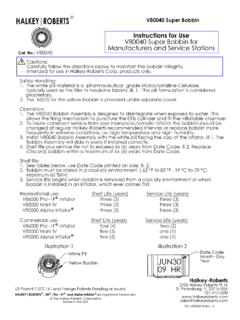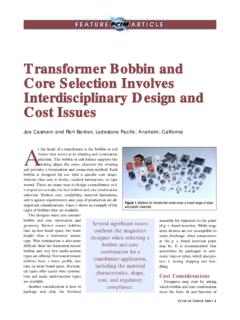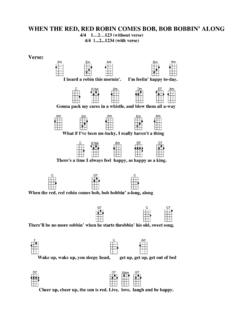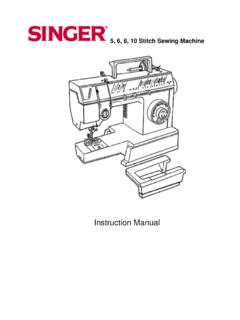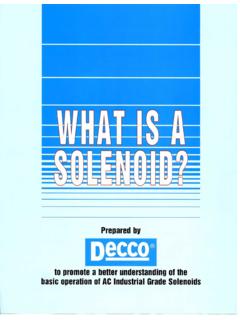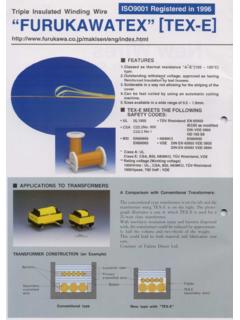Transcription of COIL BOBBIN MATERIALS - Cosmo Corp
1 COIL BOBBINMATERIALST here are many plastic compounds available on the market today. Due to the stringent requirements of coils used in industry, only a small number of these MATERIALS are appropriate for the manufacture of coil bobbins. A variety of different molding processes are used to mold bobbins in these PROCESSESTo help understand the material section, we will fi rst explain the basic molding processes that are used to mold the various types of plastic resins. This may help you to relate the MATERIALS physical and thermal properties with the cost of the MATERIALS molding process as another material selection MoldingThe method that is most widely used today for making bobbins is the injection molding process.
2 The process can be adapted to mold both thermoplastic and thermosetting MATERIALS . When using thermosetting MATERIALS , relatively cool material is injected into a hot mold and after a short period of time the mold is opened and the parts are ejected. When molding thermoplastic MATERIALS , the material is heated in the cylinder, injected and then cooled in the mold prior to removal of the MoldingTransfer molding is used with thermosetting material only. The molding material is placed into a chamber in the mold prior to the closing of the mold. An external plunger forces the material from the chamber into the mold through a system of runners. Since this all takes place in a hot mold, the material changes chemically and becomes thermally set.
3 After a prescribed time, the mold is opened Cosmo Corporation30201 Aurora RoadCleveland, Ohio 44139-2745 Phone (440) 498-7500 Fax (440) Glass Unfi lled fi lled Glass Glass Glass Liquid Thermo- Glass ASTM nylon nylon fi lled fi
4 Lled fi lled crystal setting fi lledProperty (dry as molded) Method 6/6 6/6 PBT(a) PET(b) PPS(c) polymer polyester Phenolic DAP(d)Notched izod impact, 73 F, ft-lbs/in. D-256 (e) (e) .5 .8 Tensile strength, 73 F, psi x 103 D-638 (e) 27/18(e) 22 23 9 12 Elongation, 73 F, % D-638 60/300+(e) 3/4(e) .9 - - -Flexural strength, 73 F, psi x 103 D-790 - 38 28 32 31 13 14 19 Compressive strength, psi x 103 D-695 42 18 25 26 18 40 22 Heat distortion, F, 264 psi D-648 194 480 406 435 >500 469 >500 400 400 Heat distortion, F.
5 66 psi D-648 455 500 442 475 >500 543 - - -Thermal expansion, in/in/ C x 10-5 D-696 2/4(l) .6 resistivity, ohm-cm D-257 1015/1013(e) 1015/109(e) 1015 1015 1016 1015 1014 1013 1015 Dielectric constant, 100 Hz D-150 4/8(e) (e)(f) (f) (f) (f) (k)Dielectric strength, v/mil. 1/8 thick. D-149 385/773(e)(h) 530 490 430/1040(g) 450 1110(j) 436 380 450/726(g)Oxygen index D-2873 28/31(e) 24 30 33 47 37 - - 39 Arc resistance, seconds D-495 60-120 135 123 117 34 137 >180 >180 130 Water absorption, %, 24 hrs.
6 D-570 .7 .07 .05 <.05 .02 .19 .1 .25 Flammability rating UL-94 V2 HB V0 V0 V0 V0 HB V0 V0 Specifi c gravity D-792 wire ignition, seconds UL-746 15 9 73 >300 12/300(i) <30 - - -Comparative tracking index, seconds - >599 400-599 250-399 250-399 100-174 175-259 400-599 175-259 >599 Thermoplastic (P), Thermosetting (S) - P P P P P P S S S (a) polybutelene terephthalate (b) polyethylene terephthalate (c) polyphenylene sulfi de (d) diallyl phthalate (e) (dry as molded) / (50% relative humidity) (f) 1kHz (g) (.)
7 125 inch thick molded) / (.032 inch thick molded) (h) (.125 inch thick molded) / (.048 inch thick molded) @40% RH (i) (.028 thick molded) / (>.058 inch thick molded) (j) .058 inch thick molded (k) 1kHz / 1mHz wet (l) (axial) / (transverse)ISO 9001 Certifi edand the part is MoldingCompression molding is another process used only with thermosetting MATERIALS . In this case, while the mold is still open, molding material is manually inserted into each separate cavity within the mold and then the mold is closed. The action of closing the mold causes the material to distribute itself throughout each individual cavity. As in transfer molding, the hot mold causes the material to harden.
8 After a prescribed time, the mold is opened and the parts are removed individually, since there is no runner system to hold the parts material PROPERTIESM olding MATERIALS used to produce today s parts are categorized by their properties: Thermal Flammability Electrical PhysicalThermal PropertiesUnderwriters Laboratories has segmented the range of practically experienced temperatures into a system of classifi cations. The molding material suppliers have provided MATERIALS that serve the needs of these different classifi temperature class represents the highest service temperature that the material should be able to withstand over its expected life without degrading the properties beyond the limits that UL has specifi ed.
9 This is the foundation for the insulation systems approvals available from UL (Standard 1446).The offi cially assigned temperature classifi cations do not determine the highest temperature to which any specifi c product can be approved. UL requires that products be individually approved for the temperature class specifi PropertiesFlammability ratings assigned by UL represent a material s resistance to burning, not its temperature limit or thermal life. There are fi ve ratings of fl ammability: one based on horizontal burning tests (HB), and four V ratings based on vertical burning tests. Three of these V ratings relate to the fl ammability performance of portable end-product appliances and devices.
10 The last vertical burning rating applies to parts with extensive surface area such as housings and is assigned to those MATERIALS whose test bar burns at a maximum burning rate. This is the lowest rating that UL gives to plastic MATERIALS in the fl ammability classifi is the fi rst of the ratings that specify a test using a vertical orientation to the test bar. The specimen must be extinguished within 25 seconds and any fl aming drops may not ignite is a variation on V1 in that the same orientation and time limits apply, but the material is fl uid enough that as the material starts to burn, fl aming drops will drip away and help carry the fl ame from the burning part.

